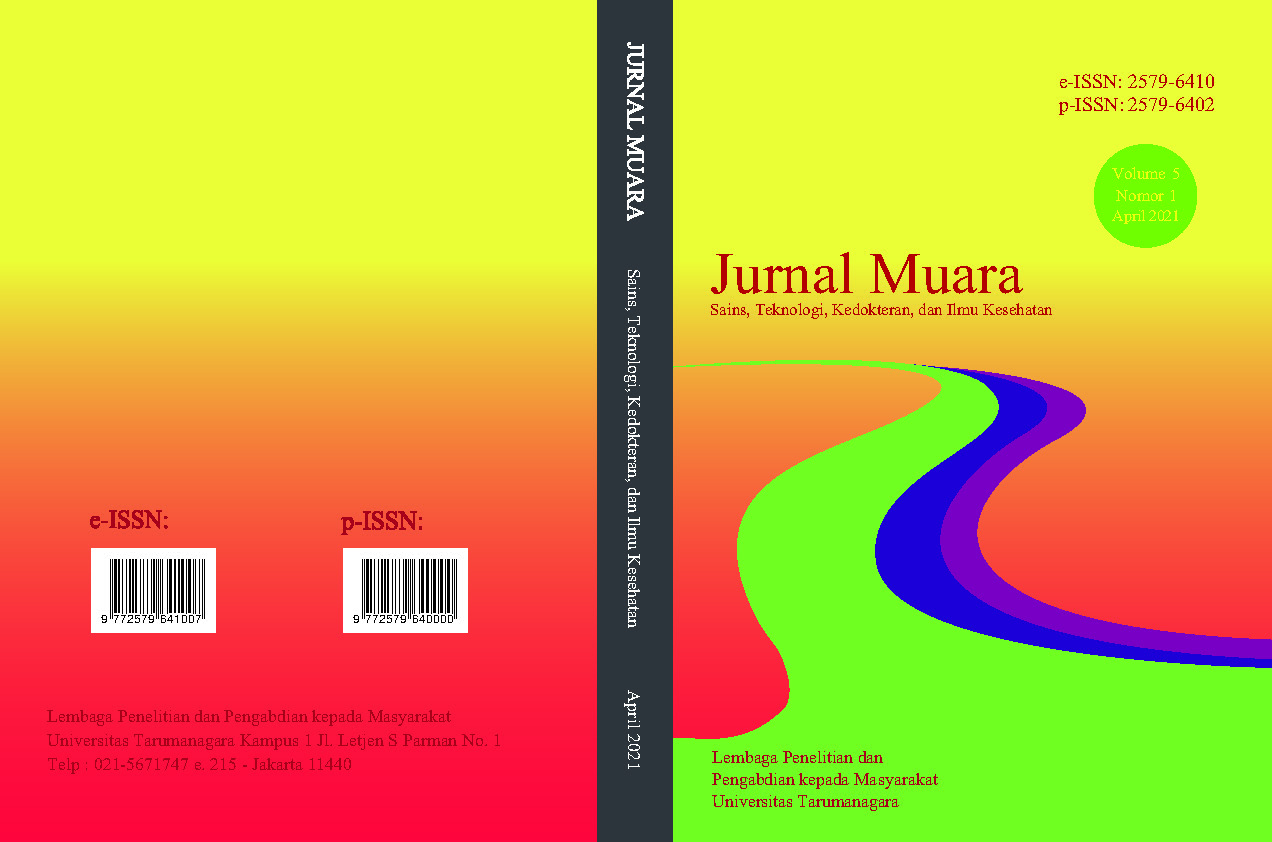PERBANDINGAN PROFIL GLUKOSA DARAH PASIEN STROKE ISKEMIK DAN STROKE HEMORAGIK DI RSUP FATMAWATI TAHUN 2018
Main Article Content
Abstract
Stroke is the death of brain cells due to lack of blood flow and oxygen to the brain by blockage or rupture of an artery. Stress hyperglycemia in acute stroke may worsen the clinical outcome and the prognosis of stroke. The purpose of this study is to find out and compare blood glucose profile between ischemic stroke and hemorrhagic stroke. This is an observational analytic cross-sectional research using consecutive sampling. Data was obtained through medical record from January to December 2018 in RSUP Fatmawati with each group of stroke consisting of 74 samples. Data was processed using SPSS 2017. Mann-Whitney test shows a significant difference in random blood glucose levels between ischemic stroke and hemorrhagic stroke (p = 0.024), with the median value of random blood glucose level during ischemic stroke is 115.50 mg / dL and hemorrhagic stroke is 136.50 mg / dL. The results also shows a significant difference in fasting blood glucose levels between ischemic stroke and hemorrhagic stroke (p = 0.042), with the median value of fasting blood glucose level for ischemic stroke is 116.50 mg / dL and hemorrhagic stroke is 125.50 mg / dL. A significant difference is also seen in 2 hours post-prandial glucose level between ischemic stroke and hemorrhagic stroke (p = 0.028), with the median value of 2 hours post-prandial glucose level of ischemic stroke is 130 mg / dL and hemorrhagic stroke is 147.50 mg / dL.
Keywords: Ischemic Stroke; Hemorrhagic Stroke; Random Blood Glucose; Fasting Blood Glucose; 2 Hour Post-Prandial Blood Glucose
Abstrak
Stroke adalah kematian sel-sel otak akibat hilangnya pasokan darah dan oksigen ke otak karena adanya hambatan atau ruptur arteri yang menuju otak. Pada stroke fase akut dapat terjadi hiperglikemia reaktif yang dapat memperburuk keluaran klinis dan prognosis stroke. Penelitian ini dilakukan untuk mengetahui dan membandingkan profil glukosa darah antara stroke iskemik dan stroke hemoragik. Penelitian ini bersifat analitik observasional dengan desain potong lintang dan pemilihan sampel consecutive sampling. Data didapat dari rekam medis periode Januari-Desember 2018 di RSUP Fatmawati dengan masing-masing kelompok stroke sebanyak 74 sampel. Pengolahan data dilakukan dengan program SPSS tahun 2017. Uji Mann-Whitney menunjukkan adanya perbedaan bermakna kadar Glukosa Darah Sewaktu antara stroke iskemik dengan stroke hemoragik (p = 0,024), dengan nilai median Glukosa Darah Sewaktu stroke iskemik adalah 115,50 mg/dL dan stroke hemoragik adalah 136,50 mg/dL. Hasil juga menunjukkan adanya perbedaan bermakna kadar Glukosa Darah Puasa antara stroke iskemik dan stroke hemoragik (p = 0,042), dengan nilai median Glukosa Darah Puasa stroke iskemik adalah 116,50 mg/dL dan stroke hemoragik adalah 125,50 mg/dL, serta adanya perbedaan bermakna kadar Glukosa Darah 2 Jam Post-Prandial antara stroke iskemik dan stroke hemoragik (p = 0,028), dengan nilai median Glukosa Darah 2 Jam Post-Prandial stroke iskemik adalah 130 mg/dL dan stroke hemoragik adalah 147,50 mg/dL.
Article Details
This work is licensed under a Jurnal Muara Sains, Teknologi, Kedokteran dan Ilmu Kesehatan Creative Commons Attribution-ShareAlike 4.0 International License.
Authors transfer copyright or assign exclusive rights to the publisher (including commercial rights)
References
Al-Weshahy, A., El-Sherif, R., Selim, K.A.A., & Heikal, A. (2017). Short term outcome of patients with hyperglycemia and acute stroke. The Egyptian Journal of Critical Care Medicine, 5(3), 93 – 98.
Benjamin, E.J. (2018). Heart Disease and Stroke Statistic – 2018 Update: A Report From the American Heart Association. American Heart Association.
Dwiputra I, Nurimaba N, Nurhayati E. (2016). Perbedaan Kadar Gula Darah Sewaktu pada stroke Iskemik Aterotrombotik dan Hemoragik Intraserebral di RSAU Dr. M. Salamun Bandung Tahun 2015.
Indiyarti, R. (2011). Perbandingan kadar gula darah sewaktu pada kedua jenis stroke. Bagian Neurologi Fakultas Kedokteran Universitas Trisakti.
Kementerian Kesehatan RI. (2018). Riset Kesehatan Dasar, Badan Penelitian dan Pengembangan Kesehatan, dan Pusat Data dan Informasi Jakarta.
Liu, J., Hou, D., Gao, Y., & Wu, J. (2018). No Association between Elevated 2-h Postprandial Blood Glucose Levels and Functional Outcomes of Small-Artery Occlusion in Patients with Diabetes. Front Neurol, 9, 93.
Mi, D., Wang, P., Yang, B., Pu, Y., Yang, Z., & Liu, L. (2018). Correlation of Hyperglycemia with Mortality after Acute Ischemic Stroke. Ther Adv Neurol Disord, 11.
Nastiti, D. (2012). Gambaran Faktor Risiko Kejadian Stroke pada Pasien Stroke Rawat Inap di Rumah Sakit Krakatau Medika Tahun 2011.
Nevzati, E., Shafigi, M., Bakhtian, K.D., Treiber, H., Fandino, J., & Fathi, A.R. (2015). Estrogen induces nitric oxide production via nitric oxide synthase activation in endothelial cells. Acta Neurochir Suppl, 120, 141-145.
Ojaghihaghighi, S., Vahdati, S.S., Mikaeilpour, A., & Ramouz, A. (2017). Comparison of neurological clinical manifestation in patients with hemorrhagic and ischemic stroke. World Journal of Emergency Medicine, 8(1), 34 – 38.
Roy-O’Reilly, M dan McCullough, LD. (2018). Age and Sex Are Critical Factors in Ischemic Stroke Pathology. Endocrinology, 159(8), 3120 – 3131.
Snarska, K.K., Bachorzewska-Gajewska, H., Kapica-Topczewska, K., & Drozdowski, W. (2016). Hyperglycemia and diabetes have different impacts on outcome of ischemic and hemorrhagic stroke. Archive of Medical Science, 13(1).
Sofyan, A.M., Sihombing, I.Y., dan Hamra, Y. (2015). Hubungan Umur, Jenis Kelamin, dan Hipertensi dengan kejadian stroke.
Stephens, M.A.C. dan Wand G. (2012). Stress and the HPA Axis. Alcohol Res, 34(4), 468 – 483.
Tan, H., Yang, W., Wu, C., Liu, B., Lu, H., Wang, H., & Yan, H. (2017). Assessment of The Role of Intracranial Hypertension and Stress on Hippocampal Cell Apoptosis and Hypothalamic-Pituitary Dysfunction after TBI. Scientific Reports, 7(1).
Thau, L. dan Sharma, S. (2019). Physiology, Cortisol. NCBI.
World Health Organization. (2011). Use of Glycated Haemoglobin (HbA1c) in The Diagnosis of Diabetes Mellitus.
Xue, W., Xu, Y., Wu, Y., & Yang, M. (2017). Observation of elevated Fasting Blood Glucose and Functional Outcome after Ischemic Stroke in Patients with and without diabetes. Oncotarget, 8(40), 67980 – 67989.
Yao, M., Ni, J., Zhou, L., Peng, B., Zhu, Y., & Cui, L. (2016). Elevated Fasting Blood Glucose is Predictive of Poor Outcome in Non-Diabetes Stroke Patients: A Sub-Group Analysis of SMART. PLoS ONE, 11(8).
Yousufuddin, M dan Young, N. (2019). Aging and Ischemic Stroke. Aging, 11(9), 2542 – 2544.



